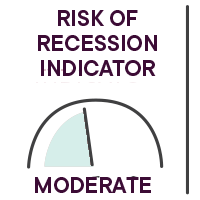Yann Furic
B.B.A., M. Sc., CFA®
Senior Portfolio Manager, Asset Allocation and Alternative Strategies
What moved the markets:
No increase in the U.S. policy rate.
Policy rate stable at 5% in Canada.
Job market still strong in both countries.

|
OVERVIEW OF GLOBAL EQUITY MARKETS |
||||
|
Country |
Index |
Return |
Change |
Year-to-date return |
|
Canada |
S&P/TSX |
-3.33% |
|
3.38% |
|
United States |
S&P 500 |
-4.83% |
|
12.82% |
|
|
Nasdaq |
-5.83% |
|
26.83% |
|
International stock markets |
EAFE |
-3.48% |
|
6.85% |
|
Emerging markets |
|
-2.68% |
|
1.60% |
|
China |
MSCI China |
-2.82% |
|
-7.49% |
* All percentages are in Canadian dollars. Source: Morningstar Direct.
Results – Canadian bonds
The FTSE Canada Universe Bond Index has posted a negative return of 1.46% year to date (at September 30, 2023).
Source : Morningstar Direct.
Our analysis of events

Monetary policies still at the forefront
The U.S. Federal Reserve decided to pause. During its September 20 meeting, the Fed announced that there would be no increase in its key rate for the moment, but it did not rule out future rate hikes. It also stated that rates will likely remain high for even longer than it had anticipated several months ago. Despite these multiple hikes, the U.S. economy continues to grow.
in Canada, the economy is slowing, which is positive in terms of controlling inflation. The job market also appears to be stabilizing. The next meeting of the Bank of Canada will be held on October 25. The market is still expecting one last rate increase by spring 2024.
In the U.S., the probability of a further rate hike is low and rate cuts are expected in the second half of 2024.
Employment still robust
Once again, job creation data in Canada in September exceeded expectations, with the addition of 63,800 jobs versus forecasts of 20,000. Wage inflation over the past 12 months is 5.3%, which is still too high for the central bank’s liking and suggests that an additional rate hike could be in the cards.
South of the border, the number of jobs created in September also exceeded expectations, but a slight increase in the unemployment rate and falling wage inflation could give the Fed enough leeway not to raise rates any further.
How are consumers doing?
- In the U.S., consumer spending now accounts for 68% of gross domestic product (GDP).
- In the coming weeks, Canadian and U.S. companies will announce their third quarter results as well as their forecasts for the fourth quarter.
- Business leaders’ views on the consumer situation and planned spending during the holiday season will be crucial in determining the likelihood of a recession and its magnitude.
- A slowdown in consumer spending should help reduce inflationary pressures and make things easier for central banks.
Economic indicators
Global Purchasing Managers’ Index ![]()
Once again in September, the indices show a marked difference between the manufacturing economy, which is slowing, and the services component, which continues to grow but which, once again, is decelerating.
Inflation rate ![]()
The inflation rate is still too high, but certain indicators are moving in the direction that central banks want to see. In Canada, wage inflation is still too strong.
Benchmark rates in Canada, Europe and the United States ![]()
If interest rates remain at current levels for a long time, significant repercussions will be felt on both household and business spending when loans are renewed. The ensuing belt-tightening will further slow individual and family consumption, as well as corporate investment.

Our strategic monitoring
We have maintained a cautious approach since the start of the year. We are keeping track of inflation as well as the leading indicators for manufacturing production, the services sector and employment. A deterioration would prompt us to be even more cautious.
A notable improvement in the manufacturing indices combined with a return to an inflation rate of 2% would be early signs of an economic recovery, but above all of a possible soft landing for the economy.
Earnings estimates for S&P 500 companies are stabilizing and even up slightly, but valuations remain high.
Caution and risk management remain priorities.
Our tactical positioning
- Tactically, we maintained our position in U.S. large cap growth stocks because they react positively to stabilizing interest rates, as well as in stocks with a track record of dividend growth which are more defensive.
- We continue to favour large cap stocks in developed countries.
- Since the Bank of Canada’s policy rate increase in early June, we have taken a position in 10-year Canadian bonds, as we believe that longer-term rates will peak over the next few months and then stabilize or decline.
- We increased the weighting of 10-year Canadian bonds in July and August, as well as in the early days of October.
To learn how our funds performed:
View the returns
Main risks
- An overly restrictive monetary policy could cause a major recession or other problems, like the U.S. regional bank crisis.
- High interest rates for an extended period would reduce corporate profits and dampen household spending.
- The possibility of an episode of stagflation, i.e. anemic economic growth and high inflation, persists. This situation is negative for stock markets.
- The Israeli-Palestinian conflict could escalate and spread to other territories in the Middle East.
- The conflict in Ukraine could worsen and spread to other European countries. Grain prices could increase following Russia’s cancellation of the maritime transport agreement in this region, which could contribute to food inflation.
- There is also a risk that tensions could worsen between China and the United States over Taiwan.
Senior Manager, Asset Allocation and Alternative Strategies
Data source : Bloomberg
The opinions expressed here and on the next page do not necessarily represent the views of Professionals’ Financial. The information contained herein has been obtained from sources deemed reliable, but we do not guarantee the accuracy of this information, and it may be incomplete. The opinions expressed are based upon our analysis and interpretation of this information and are not to be construed as a recommendation. Please consult your Wealth Management Advisor.




















